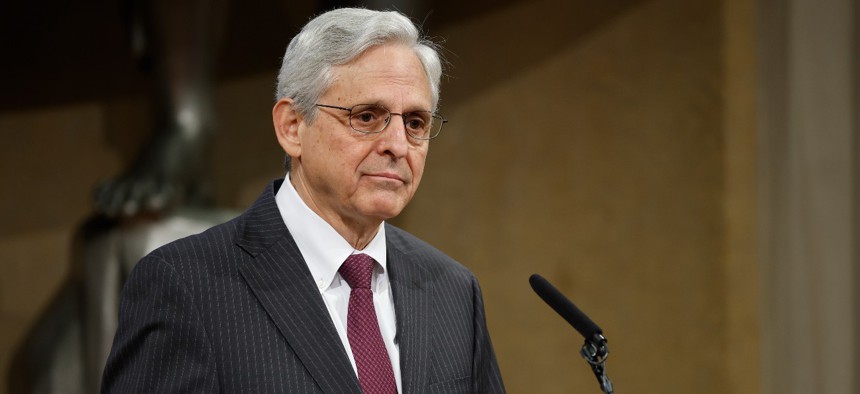Federal Officers Must De-Escalate Before Using Force and Intervene When Colleagues Abuse Power, DOJ Says
The changes were part of the Justice Department's first use-of-force policy update in 18 years.
The Justice Department will soon require its law enforcement employees to prioritize de-escalation when involved in potentially dangerous situations and to proactively intervene when colleagues are engaging in use of force under its first policy update for staff in 18 years.
The new guidelines will allow the federal officers and agents to use force only when “no reasonably effective, safe and feasible alternative appears to exist,” Attorney General Merrick Garland said. Employees can deploy deadly force only when they reasonably believe a suspect is posing an imminent threat of death to themselves or others. If the subject of potential force is only threatening to harm themselves or property, deadly force should not be used. Officers should issue a verbal warning before shooting their firearm if doing so is feasible and would not risk anyone’s safety.
Under the new policy, which was last updated in 2004, Justice will train officers in their “affirmative duty” to intervene when any other officer is engaging in excessive force as defined by the Constitution, federal law or department policy. Employees, the guidelines state, must step in to stop their colleagues from abusing their power. They similarly will be trained in their duty to request or provide medical aid, as appropriate.
“The policy reflects the excellence we have come to expect from the department's officers and agents, while protecting their safety and the safety of the people and communities we serve,” Garland said.
Justice will train its officers annually on the department’s use of force policy. They will also receive “regular and periodic” training that reinforces the importance of de-escalation, simulates shooting scenarios and emphasizes the appropriate use of less-than-lethal force. The department must document all use-of-force trainings.
Justice updated its policy to align with guidelines put forward by a coalition of federal, state and local law enforcement groups in 2020, as well as Supreme Court cases that have set standards on the use of force. It will go into effect on July 19 and each department component will designate an official to oversee implementation.
Under the policy, employees cannot use their firearms solely to prevent a fleeing suspect from escaping, including by shooting at a moving vehicle. They cannot use warning shots outside of prisons. Officers will receive new training on how to handle resisting subjects without using deadly force. The policy emphasizes the necessity of de-escalation generally, calling on officers to deploy those tactics as long as it does not create a more dangerous environment.
“When feasible, reducing the need for force allows officers to secure their own safety as well as the safety of the public,” Garland wrote.
The update follows the Biden administration reaching a settlement agreement with several organizations earlier this year that sued the government for its violent response to racial justice protests that occurred after the police killing of George Floyd in 2020. Both the U.S. Park Police and Secret Service agreed to update their policies when responding to demonstrations, including visible badges and nameplates, new guidelines on the use of non-lethal force and clearer warnings to disperse before they engage in forceful actions. The agencies acknowledged that when some demonstrators have engaged in unlawful conduct it does not give federal agents permission to use force or disperse a crowd.
Last year, Justice issued a new policy requiring body cameras for law enforcement officers engaged in executing search warrants and making pre-planned arrests. In the recent omnibus funding bill for fiscal 2022, agencies through government received new money to set up or further develop body camera programs for law enforcement officers.








